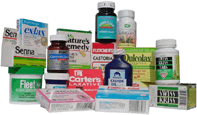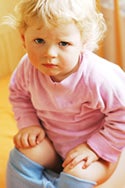Is Luctolose Work for Severe Constipation for Babies
Treatment of Chronic Constipation
Constipation in children can be treated in many different ways. In the end, most treatments revolve around three basic principals:
- Empty the large intestine
- Establish regular bowel movements
- Eliminate the pain associated with passing bowel movements
Early on, constipation can often be treated by changing a child's diet. But once the constipation becomes chronic, laxatives are usually needed to re-establish regular bowel movements and eliminate the pain associated with passing bowel movements.
Step 1: How do we empty the large intestine?
Three methods are commonly used to empty the large intestine:
- Enemas
- Suppositories
- Laxatives
Enemas push fluid into the rectum. This softens the stool in the rectum but also stretches the rectum, giving the child a tremendous urge to pass a bowel movement. Almost all enemas consist mostly of water with something else mixed in to keep the water inside the intestine. The most commonly used enemas are:
- Fleet's® Phosphosoda: contain water and the salt sodium-phosphate. The phosphate is not absorbed in the lower intestine and thus keeps the water from the enema in the intestine.
- Soap suds: contain water with a small amount of soap. The soap is mildly irritating and stimulates the lower intestine to secrete water and salt.
- Milk and Molasses: contain milk sugars and proteins as well as molasses. None of these are absorbed in the lower intestine and thus keep the water from the enema in the intestine.
Suppositories irritate the bottom of the intestine, causing it to contract (squeeze) and push out a bowel movement. Some suppositories also stimulate the intestine to secrete salt and water, softening the stool in the rectum and making it easier to push out. Commonly used suppositories include:
- Glycerine
- Dulcolax®
- BabyLax®
Powerful Laxatives "flush out" the lower intestine. This generally keeps lots of water in the intestine, softening any stool there, and causing diarrhea. Laxatives commonly used to flush out the intestine include:
- Magnesium citrate
- Golytely® or Colyte®
- Fleet's Phosphosoda®
- Miralax® or Glycolax®
Step 2: How can we re-establish regular bowel movements?
Once the large intestine has been emptied, laxatives are administered regularly to produce soft bowel movements once or twice each day. Virtually any laxative preparation will be effective if it is given in high enough doses.
 Most of the commonly used laxatives contain different elements but produce basically the same end results: the element is poorly or not absorbed by the intestinal tract, the element stays in the intestine keeping water with it, much more water stays in the stool, the stool stays very soft and moves through the intestine more quickly.
Most of the commonly used laxatives contain different elements but produce basically the same end results: the element is poorly or not absorbed by the intestinal tract, the element stays in the intestine keeping water with it, much more water stays in the stool, the stool stays very soft and moves through the intestine more quickly.
- Milk of Magnesia® and Haley's M.O.®
Contain magnesium salts. In high doses, often produce diarrhea. - Lactulose (Chronulac® and Duphalax®)
Contains a sugar. Often causes bloating and excessive amounts of intestinal gas. In high doses, often produces diarrhea. - Sennokot®, Fletcher's Castoria®, Ex-Lax®, Aloe Vera
Contain the natural plant derivative senna. Also a mild irritant, senna causes the lower intestine to contract (squeeze). In high doses, may cause cramps and diarrhea. - Polyethylene glycol 3350 (Miralax® or Glycolax®)
Contains a very large polymer of ethylene glycol. Available as a tasteless, odorless powder that can be readily mixed into juices or other fluids without altering their taste. In high doses, often produces diarrhea. - Mineral Oil
A non-absorbable oil digested by bacteria living in the large intestine. By-products of this digestion stimulate the intestine to secrete salt and water. Many people believe mineral oil works by "lubricating the intestine". In high doses, often causes some orange seepage and some itching at the anus. - Metamucil®, Citrucel®, Fibercon®, Fiberall®, and Maltsupex®
Fiber-based laxatives containing complex sugars not digested or absorbed in the intestine. In high doses, often cause bloating and gas.
Can diet accomplish the same thing as these laxatives?
In high enough doses, many foods, especially fruits and juices, can be very effective laxatives. But it is often difficult to eat or drink enough of these foods day-in and day-out to be an effective long-term treatment. Many people are familiar with using prunes as laxatives. Much like fiber laxatives, prunes contain complex sugars that are not digested or absorbed in the intestine. As a result, the sugars remain in the intestine and keep water with them. As with fiber laxatives, high doses of prunes often produce bloating and gas.
Are laxatives safe?
While many parents and physicians are worried about using laxatives in children, most of their concerns are unfounded. Somecommon misconceptions include:
- Children may become "dependent" on laxatives if they use them too long?
Because nearly all available laxatives work by keeping large amounts of water in the stool, they can be used for very long periods of time without significant risk. There is no evidence that any of the laxatives described above can result in dependency with chronic usage. - Laxatives lose their effectiveness if they are used for prolonged periods?
No studies have ever convincingly demonstrated that any of the laxatives described above lose their effectiveness over time. - Children who use laxatives have an increased risk of developing colon cancer?
Several studies have suggested that adults with untreated constipation may be at increased risk for developing colon cancer, but there is no evidence to suggest that laxatives increase this risk.
How long does treatment need to continue?
Length of treatment varies from child to child. In general, we must treat younger children for longer periods of time than older children.
- Children 5-6 years of age and older: 3-4 months of continuous laxative therapy is usually sufficient to reverse many of the problems described above
- Children under 5 years of age: we usually recommend continuous treatment with laxatives for at least 6 months, sometimes as long as 1 year
Younger children need to be treated longer than older children not because the problem is more severe, but because of their developmental stage. Young children are "magical thinkers" . . .they don't associate cause and effect the same way older children or adults do, so we need to treat them long enough that they lose the association between passing bowel movements and pain . . .they need to forget the pain. Toddlers are like elephants,they never forget!
Step 3: How can we eliminate the pain associated with bowel movements?
The key to eliminating pain associated with bowel movements is to be sure the bowel movements are soft and not particularly large. In children who have chronic anal fissures, it may be necessary to administer some form of medicine that is soothing and promotes the healing process.
Are there other things we can do to make treatment easier and more effective?
Almost all treatment regimens revolve around evacuating the intestine and using laxatives to keep the stools soft. A number of behavioral techniques can also be quite helpful:
Establish regular "bathroom times"

Children who are toilet trained should get in the habit of sitting on the toilet for 5-10 minutes after breakfast and again after supper. Many families have very busy schedules and their children are not in the habit of "making time" to pass bowel movements. Establishing regular "bathroom times" after meals takes advantage of intestinal contractions that occur after we eat. These contractions are often called the "gastro-colic reflex" and explain why some people pass bowel movements every morning after breakfast or every evening after supper. Establishing regular bathroom times is also helpful because many children are completely unwilling to pass bowel movements at school (just as many adults are unwilling to do at work).
Biofeedback therapy
Some pediatric centers offer biofeedback therapy as a way to improve the muscle coordination associated with passing bowel movements. Remember, many children with chronic constipation have become quite incoordinated and use muscles against one another when they try to pass bowel movements. With biofeedback, several small wires are taped to the skin around the anus and on the abdomen. These wires measure what the different muscles are doing and display this information on a TV screen. By playing a type of video game, a child can learn how to tighten and relax the muscles in ways that make passing bowel movements more efficient and less painful.
Behavioral therapy
In older children, we often find that in conjunction with the use of laxatives and enemas, the aid of a behavioral psychologist to enlist the child's help in his or her own cure is very worthwhile. At the UVA Children's Hospital we have a program called "enhanced toilet training". With the assistance of behavioral psychologists, we use modeling and other behavior modification techniques to help children understand how to use their muscles correctly while straining.
Is Luctolose Work for Severe Constipation for Babies
Source: https://med.virginia.edu/pediatrics/clinical-and-patient-services/patient-tutorials/chronic-constipation-encopresis/treatment-of-chronic-constipation/
0 Response to "Is Luctolose Work for Severe Constipation for Babies"
Kommentar veröffentlichen